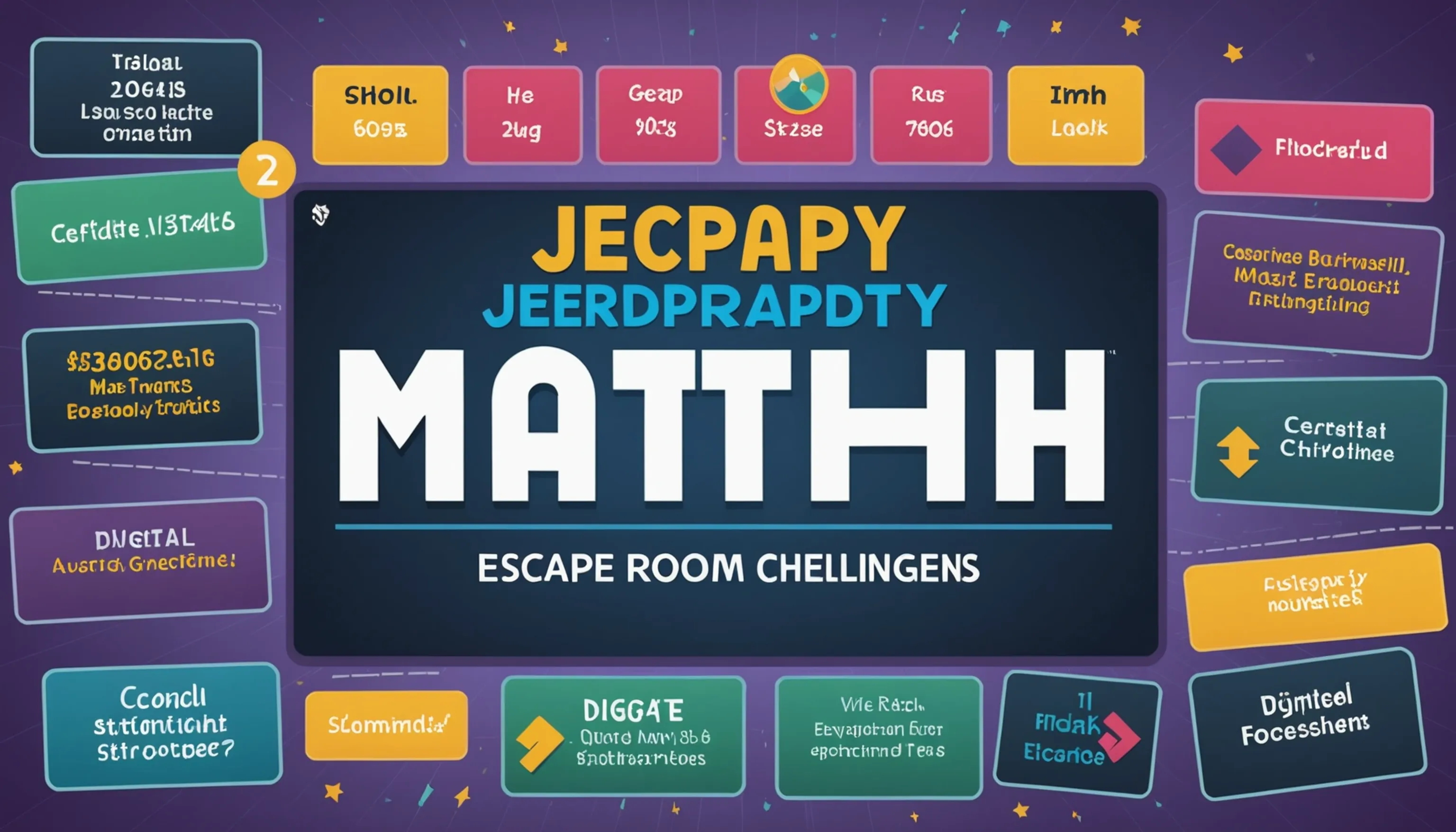Creative Math Games for Learning
 HvWHenry van Wagenberg
HvWHenry van Wagenberg
Creative Math Games for Learning
Creative math games for learning offer an engaging way to help teenagers grasp mathematical concepts while having fun. These games can be played in classrooms or at home, making them versatile tools for parents and teachers alike. By integrating elements of competition and teamwork, students are more likely to stay motivated and focused on their math skills. Moreover, creative games often encourage critical thinking and problem-solving, essential skills in both academic and real-life situations. Whether it's through board games, card games, or interactive online formats, there are countless options available to make learning math an enjoyable experience.
Why Use Games to Teach Math?
Using games to teach math is an effective strategy that transforms learning into an enjoyable experience. Traditional methods can sometimes lead to disengagement, especially among teenagers. However, incorporating games into math lessons helps capture students' attention and makes the subject more relatable.
One primary reason to use games is their ability to foster a positive learning environment. Games encourage friendly competition, which can motivate students to participate actively. When students are having fun, they are more likely to engage with the material and retain information. This engagement is crucial for complex subjects like math, where understanding builds upon previous knowledge.
Additionally, games provide opportunities for hands-on learning. Many math concepts can be abstract and challenging to grasp. By using physical or digital games, students can visualize problems and manipulate variables, making the learning experience more concrete. For example, games like Math Bingo or Escape Room challenges allow students to apply their skills in practical scenarios.
Moreover, games promote critical thinking and problem-solving skills. As students navigate challenges within the games, they learn to strategize, make decisions, and adapt their approaches. This skill set is invaluable not only in mathematics but also in real-world situations.
In summary, using games to teach math enhances engagement, promotes hands-on learning, and develops essential skills. By making learning interactive and enjoyable, students are more likely to embrace math and develop a lifelong appreciation for the subject.
Benefits of Creative Math Games
Creative math games offer a multitude of benefits that can significantly enhance the learning experience for teenagers. First and foremost, these games make math fun, transforming what can be a daunting subject into an engaging activity. When students enjoy what they're learning, their motivation increases, leading to better retention of concepts.
One major benefit of creative math games is that they cater to various learning styles. Visual learners can benefit from games that incorporate graphics and visual aids, while kinesthetic learners can engage through hands-on activities. This adaptability helps reach a broader audience, ensuring that all students can grasp mathematical concepts effectively.
Additionally, creative math games encourage collaboration and social interaction. Many games require teamwork, allowing students to communicate, share ideas, and work together towards a common goal. This collaborative environment not only fosters social skills but also encourages peer learning, where students can learn from one another’s strengths and weaknesses.
Furthermore, these games often incorporate real-world scenarios, making math relevant to everyday life. When students see the practical applications of what they are learning, they are more likely to appreciate the subject and its importance.
Finally, creative math games provide immediate feedback. This instant response allows students to recognize their mistakes and learn from them in real-time, promoting a growth mindset. In summary, the benefits of creative math games extend beyond mere enjoyment; they play a vital role in effective learning, collaboration, and real-world application of mathematical concepts.

Top Creative Math Games to Try
Here are some top creative math games to try with teenagers that make learning enjoyable:
- Math Jeopardy: A quiz-style game where students answer questions from various math categories, promoting competition and teamwork.
- Math Bingo: Players mark off numbers on their bingo cards based on math problems called out by the teacher, combining fun with calculation.
- Escape Room Math Challenges: Teams solve math puzzles to 'escape' a themed room, integrating problem-solving and critical thinking.
- Math Apps: Explore engaging apps like Prodigy or Kahoot! that gamify math learning through interactive challenges.
Math Jeopardy
Math Jeopardy is an engaging and interactive game that combines the excitement of a quiz show with the challenge of mathematical problem-solving. This game can be easily tailored to fit various grade levels and topics, making it a versatile choice for both classrooms and home learning.
In Math Jeopardy, players are divided into teams and presented with a game board filled with categories and point values. Each category contains questions of varying difficulty, allowing students to choose their preferred topics. For instance, categories could include Algebra, Geometry, Fractions, or Word Problems.
The game begins when a team selects a category and point value. The teacher or game host then reads the corresponding question, which can be phrased as an answer, requiring players to respond in the form of a question, just like in the classic TV show. This format encourages quick thinking and helps students practice phrasing their answers correctly.
Math Jeopardy promotes teamwork and collaboration as students discuss their answers and strategies. It also fosters a sense of healthy competition among teams, motivating them to perform their best. Additionally, the game can be adapted for digital platforms, making it accessible for online learning environments.
Overall, Math Jeopardy not only reinforces math skills but also makes learning fun and interactive. Its competitive nature and group dynamics create an exciting atmosphere that encourages students to engage deeply with mathematical concepts.
Math Bingo
Math Bingo is a dynamic and enjoyable game that combines the classic Bingo format with essential math skills. This game is perfect for students of various ages and can be adapted to focus on different mathematical concepts, such as addition, subtraction, multiplication, division, or even more advanced topics like fractions and decimals.
To play Math Bingo, each student receives a Bingo card filled with numbers related to the chosen math concept. The teacher calls out math problems instead of numbers, and students must solve the problems to find the corresponding answers on their cards. For example, if the teacher calls out "5 + 3," students would look for the number "8" on their cards.
Math Bingo not only helps reinforce math skills but also enhances listening and critical thinking abilities. As students listen to the problems being called, they must quickly solve them and determine whether they have the answer on their card. This fast-paced environment keeps students engaged and encourages them to think on their feet.
Additionally, Math Bingo can be played in various formats, including small group sessions or whole-class activities, making it a versatile tool for educators. Prizes can also be offered to increase motivation, such as stickers or small treats for winners.
In conclusion, Math Bingo is an effective and fun way to practice mathematical concepts, fostering a love for math while promoting collaboration and friendly competition among students.

Escape Room Math Challenges
Escape Room Math Challenges are an innovative and immersive way to engage students in mathematics while promoting critical thinking and teamwork. This format mimics the popular escape room experience, where participants must solve puzzles and riddles to 'escape' within a set time limit. By incorporating math problems into the challenges, educators can create a fun, dynamic learning environment that encourages collaboration.
In an Escape Room Math Challenge, students are divided into small teams, each presented with a unique scenario or theme. For example, they might be trapped in a mysterious lab or stranded on a deserted island. To escape, they must work together to solve a series of math-related tasks. These tasks could range from solving equations to decoding messages using mathematical principles.
The challenges can be designed to cater to various skill levels, ensuring that all students can participate and contribute. Additionally, the time constraint adds an element of excitement and urgency, motivating students to think quickly and strategize effectively.
Teachers can set up physical escape rooms in the classroom or use online platforms to create virtual challenges. This flexibility allows educators to adapt the activity based on their resources and student needs.
Overall, Escape Room Math Challenges provide an engaging way to reinforce math skills while fostering essential life skills such as teamwork, communication, and problem-solving. By making math interactive and enjoyable, students are more likely to develop a positive attitude toward the subject.
Incorporating Technology in Math Games
Incorporating technology in math games enhances the learning experience for teenagers by making it more interactive and engaging. Digital platforms and applications provide a variety of resources that cater to different learning styles and preferences. For instance, math apps such as Prodigy and Khan Academy offer personalized learning paths, allowing students to progress at their own pace.
Online math game platforms like Kahoot! and Quizizz enable teachers to create custom quizzes that make learning competitive and fun. These tools can facilitate real-time feedback, helping students identify areas for improvement immediately.
Moreover, virtual reality (VR) can take math learning to new heights by immersing students in 3D environments where they can explore mathematical concepts visually and tangibly. By integrating technology into math games, educators can create a more dynamic and effective learning environment that prepares students for the digital world.
Math Apps for Teens
Math apps for teens have revolutionized the way students engage with mathematical concepts, making learning both accessible and enjoyable. These applications provide interactive platforms that cater to various learning styles and levels, ensuring that all students can find resources tailored to their needs.
One of the most popular math apps is Prodigy, which gamifies math practice by immersing students in a fantasy world where they solve math problems to advance in the game. This engaging format motivates teens to practice regularly without feeling overwhelmed by traditional methods.
Another excellent resource is Khan Academy, which offers comprehensive lessons, practice exercises, and instructional videos covering a wide range of math topics. The app allows students to learn at their own pace, enabling them to revisit challenging concepts as needed.
Photomath is another innovative app that allows students to take pictures of handwritten or printed math problems and provides step-by-step solutions. This feature not only aids in homework completion but also helps students understand the processes involved in solving problems.
Lastly, Microsoft Math Solver offers similar capabilities, along with additional resources such as video tutorials and practice questions. With these apps, teens can enhance their math skills, build confidence, and develop a positive attitude towards the subject.
Online Math Game Platforms
Online math game platforms have become invaluable resources for educators and students alike, offering engaging ways to reinforce mathematical concepts while promoting interactive learning. These platforms provide a variety of games and activities that cater to different skill levels, making math accessible and enjoyable for all students.
One of the most popular platforms is Kahoot!, which allows teachers to create custom quizzes and games that students can participate in using their devices. This interactive format encourages friendly competition and collaboration, motivating students to engage with math in a fun way. Teachers can track progress in real-time, identifying areas where students may need additional support.
Another excellent platform is IXL, which offers a comprehensive range of math problems across various grades and topics. It provides immediate feedback and personalized recommendations based on students' performance, allowing for tailored practice that meets individual needs.
Prodigy is another standout platform that gamifies learning by immersing students in a fantasy world where they solve math problems to progress. This engaging approach keeps students motivated and encourages regular practice without the pressure often associated with traditional methods.
Overall, online math game platforms not only make learning math more appealing but also foster a sense of community among students as they collaborate and compete. By integrating these tools into their curriculum, educators can create a dynamic learning environment that enhances students' understanding and appreciation of mathematics.
Using Virtual Reality for Math Learning
Using virtual reality (VR) for math learning is an innovative approach that offers immersive educational experiences for students. This technology allows teens to interact with mathematical concepts in a three-dimensional environment, making abstract ideas more tangible and relatable. By leveraging VR, educators can create engaging scenarios that enhance understanding and retention of complex topics.
One of the key benefits of VR in math education is its ability to visualize difficult concepts. For instance, students can explore geometric shapes and their properties in a virtual space, allowing them to manipulate and examine these shapes from different angles. This hands-on experience can significantly deepen their understanding of spatial relationships and measurements.
Additionally, VR can facilitate real-world applications of math. Students can simulate scenarios such as budgeting for a project or calculating distances while navigating through a virtual city. These practical experiences help students see the relevance of math in everyday life and develop critical thinking skills.
Several educational platforms, such as zSpace and GeoGebra VR, are leading the way in integrating VR into math curricula. These platforms offer interactive lessons and challenges that encourage collaboration among students, fostering teamwork while they learn.
In conclusion, using virtual reality for math learning is a powerful tool that transforms traditional teaching methods. By providing immersive experiences, VR enhances engagement, supports diverse learning styles, and prepares students for a future where technology plays an integral role in education and beyond.
